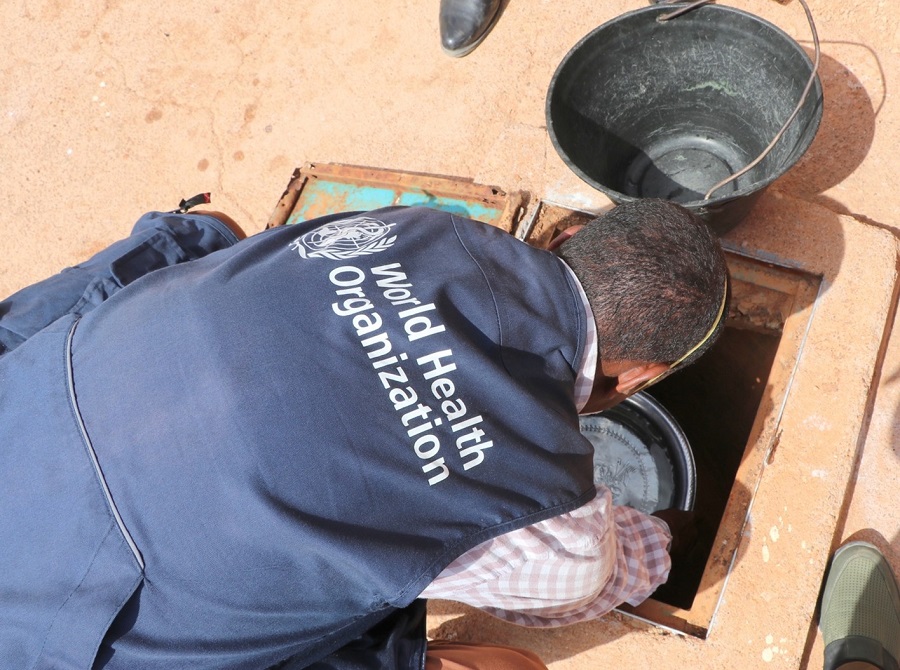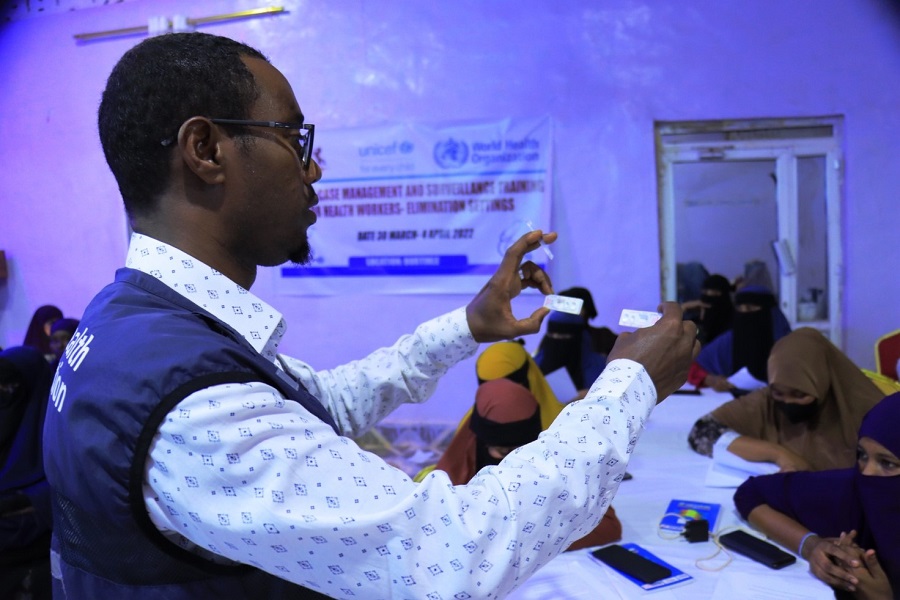 A WHO staff member inspecting a small water tank to identify and control mosquito breeding sites. Credit: WHO
A WHO staff member inspecting a small water tank to identify and control mosquito breeding sites. Credit: WHO
Mogadishu 25 April 2023 – The Federal Ministry of Health, together with the World Health Organization (WHO) Somalia, commemorates World Malaria Day on 25 April to reflect on the progress made in the fight to eliminate malaria. Malaria continues to pose a significant threat to the health and well-being of millions of people globally, particularly in sub-Saharan Africa, where most malaria cases and deaths occur. On this year's World Malaria Day, WHO emphasizes the importance of implementing strategies and reaching marginalized populations in the fight against malaria. As part of this year’s theme "Time to deliver zero malaria: invest, innovate, implement" campaign, WHO highlights the critical need to provide access to diagnostics, treatment and care for those who need them most.
Significant progress has been made in malaria control in Somalia, with substantial decreases in transmission since 2019, thanks to scaled up interventions. Additionally, the impact of the drought in Somalia has contributed to reducing malaria transmission across the country, including in previously high and moderate transmission areas along the Shabelle and Jubba Rivers. Despite a high risk of epidemics in northern regions, malaria infections in the community remain low and much of the country is suitable for elimination efforts.
Throughout Somalia, the malaria species Plasmodium falciparum has been the predominant cause of infection, accounting for over 92% of cases. This poses a complex situation due to the severity of malignant malaria. Furthermore, the invasive mosquito species Anopheles stephensi, capable of transmitting both P. falciparum and P. vivax malaria parasites, was detected in 6 locations in Somalia between 2020 and 2021. Unlike other major mosquito vectors of malaria, Anopheles stephensi thrives in urban environments, making vector control a top priority for the malaria programme.
On the road to zero malaria
The WHO Country Office, in collaboration with other stakeholders, mainly UNICEF, with support from the Global Fund to Fight AIDS, Tuberculosis and Malaria, provides support to the health authorities in efforts to tackle malaria transmission in the country. These include indoor residual spraying (IRS), distribution of long-lasting insecticidal nets (LLINs), larval source management, and malaria case management. WHO also supports the Government in strengthening surveillance and entomological monitoring efforts in the country, as well as monitoring insecticide susceptibility and drug efficacy on malaria parasites.
Dr Jamal Ghilan Amran, the Malaria Focal Point for WHO Somalia, emphasised the significance of adopting an integrated approach to prevent malaria. He stated, "Malaria prevention and surveillance are crucial elements of malaria elimination, mainly in the northern and central regions. Without efficient and coordinated prevention measures, coupled with robust surveillance, monitoring, and timely response to transmission pattern changes, we risk forfeiting the progress we have made in combating malaria."
In Somalia, malaria is endemic across the country, particularly in the south and central parts of the country. However, the country has decided that conditions were right to target 6 districts for elimination as a pilot project – Odweyne in the region of Togdher; Ainabo in Sool; Burao in Togdher; Sheikh in Sahil; Burtinle in Nugal; and Goldogob in Mudug – all in Somaliland and Puntland. Planning for other regions would have been a challenge, mainly due to insecurity. As a result, from May 2021 onwards, led by the Somali Government and supported by the Global Fund, WHO and UNICEF are rolling out national malaria elimination programmes in these 6 districts towards reaching the zero malaria target.
In 2022, 336 840 suspected malaria cases were tested, of which 11 550 were positive. Compared with 2021 and 2020, the positive cases declined by 11% and 61%, respectively. A total of 2 malaria-related deaths were also reported in 2022. All these cases were treated with artemisinin-based combination therapy as per the national treatment guidelines.
Similarly, in 2021 and 2022, WHO provided technical support to implement IRS interventions in Mogadishu, Qardo, and parts of Puntland and Somaliland. The intervention exceeded the initial target, with 85 837 households sprayed. Between June 2022 and March 2023, the LLINs mass campaign, supported by UNICEF, distributed almost 2.9 million bednets in 31 selected districts, including over 1.4 million LLINs distributed to internally displaced persons. Prior to the campaign, there was an extensive engagement between sub-recipients, the national malaria control programme, WHO, and UNICEF. This involved quantification and detailed microplanning. Additionally, the national LLIN distribution guidelines were updated to provide essential guidance to the government and distribution partners.
 WHO conducts malaria case management and surveillance training for health workers 30 March–4 April 2022, Burtinle, Puntland. Credit: WHO
WHO conducts malaria case management and surveillance training for health workers 30 March–4 April 2022, Burtinle, Puntland. Credit: WHO
Further, entomological monitoring and surveillance have been enhanced through the reinforcement of sentinel sites and improved insecticide resistance monitoring, which aligns with the 2019 insecticide resistance monitoring plan that is currently being updated. Vector control has been incorporated into primary health care, and there is an emphasis on the collection of comprehensive entomological surveillance data. These data are used to identify malaria vectors, including Anopheles stephensi, and to monitor the spread, geographical and temporal distribution, and density of these mosquitoes, as well as their feeding and resting behaviours.
Although Somalia has made significant progress in controlling and eliminating malaria, much work remains to be done. This includes raising awareness about malaria prevention, community and private sector involvement, enhancing cross-border collaboration to prevent the importation of vectors and parasites, and ultimately achieving the goal of zero malaria-related deaths.
Global burden of malaria
According to the latest World Malaria Report 2022, from 2000 to 2015, the number of malaria cases decreased steadily; however, since 2016, malaria cases have been increasing. The most considerable increase was observed during the first year of the COVID-19 pandemic, between 2019 and 2020, with a rise of 13 million cases. In 2021, an estimated 247 million malaria cases and 619 000 deaths were reported. The WHO African Region bears the brunt of this burden, with 95% of malaria cases and 96% of deaths occurring in the Region. Children under 5 years old account for 80% of all malaria deaths in the Region.
The WHO Global Technical Strategy for Malaria 2016–2030 aims to reduce malaria incidence and mortality rates by at least 90% by 2030, eliminate malaria in at least 35 countries, and prevent a resurgence of malaria in all malaria-free countries.
------------------
For additional information, please contact:
Kyle DeFreitas
External Relations Officer
Fouzia Bano
Communications Officer
Related links
/somalia/news/at-risk-zero-dose-children-get-vaccines-as-somalia-drought-woes-mount.html
https://www.who.int/teams/global-malaria-programme/reports/world-malaria-report-2022


